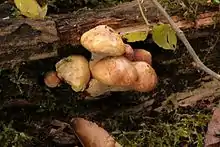| Gymnopilus braendlei | |
|---|---|
 | |
| Scientific classification | |
| Domain: | Eukaryota |
| Kingdom: | Fungi |
| Division: | Basidiomycota |
| Class: | Agaricomycetes |
| Order: | Agaricales |
| Family: | Hymenogastraceae |
| Genus: | Gymnopilus |
| Species: | G. braendlei |
| Binomial name | |
| Gymnopilus braendlei | |
| Synonyms[1] | |
| |
| Gymnopilus braendlei | |
|---|---|
| Gills on hymenium | |
| Cap is convex | |
| Hymenium is adnexed or adnate | |
| Spore print is yellow-orange | |
| Ecology is saprotrophic | |
| Edibility is psychoactive | |
Gymnopilus braendlei is a species of agaric fungus in the family Hymenogastraceae that contains the hallucinogens psilocybin and psilocin.[2] It was originally described by mycologist Charles Horton Peck as Flammula braendlei, from specimens found in the District of Columbia in 1902.
Description
- Pileus: 2.5–5 cm, hemispheric becoming convex, sometimes slightly umbilicate, hygrophanous, purplish when young then pinkish and lighter towards the margin, becoming yellowish in age with greenish stains, fibrillose, sometimes squamulose toward the center, flesh whitish, thin, staining greenish.
- Gills: Adnate, sometimes slightly sinuate in attachment, broad, close, whitish when young, becoming bright orangish brown to mustard yellow, becoming bright orangish brown in age.
- Spore print: Orangish brown.
- Stipe: 2.5–4 cm x 3–4 cm thick, more or less equal, pallid, sometimes yellowish at the base, fibrillose above, stuffed or hollow, veil fibrillose, sometimes leaving a silky zone but not forming an annulus.
- Taste: Bitter
- Microscopic features: Spores 6 x 8.5 x 4.5—5 µm ellipsoid to ovoid in face view, dextrinoid, verruculose, no germ pore. Pleurocystidia 22—33 x 6—7 µm, cheilocystidia 20—34 x 3—7 µm, no caulocystidia, clamp connections present.
- Bruising: Green or blue bruising at the base or on the pileus, and green spots on pileus likely.
Distribution and habitat
Gymnopilus braendlei is found growing solitary or cespitose on tree stumps from June to November. It is widespread in the eastern U.S, and present in the western U.S.
See also
References
- ↑ "Gymnopilus braendlei (Peck) Singer :561, 1951". MycoBank. International Mycological Association. Retrieved 2013-01-02.
- ↑ Gastón Guzmán; John W. Allen; Jochen Gartz (1998). "A worldwide geographical distribution of the neurotropic fungi, an analysis and discussion" (PDF). Annali del Museo Civico di Rovereto (14): 189–280. (on Fondazione Museo Civico di Rovereto)
- Peck CH. (1904). New species of fungi. Bulletin of the Torrey Botanical Club 31(4): 177–182.
- Hesler, L. R. (1969). North American species of Gymnopilus. New York: Hafner. 117 pp.
This article is issued from Wikipedia. The text is licensed under Creative Commons - Attribution - Sharealike. Additional terms may apply for the media files.